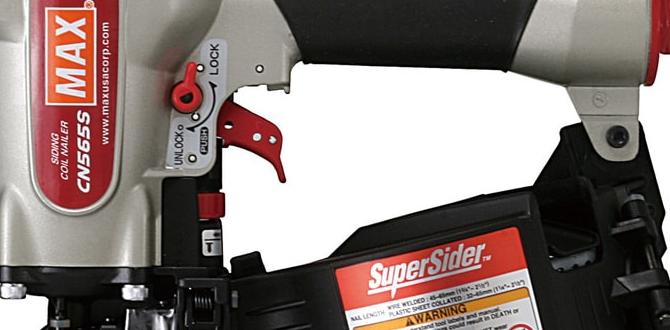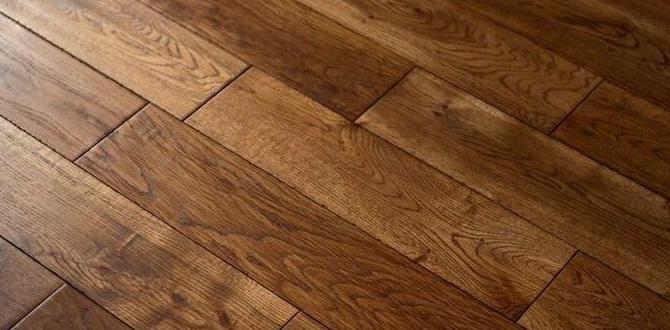For trim work, a nailer is the proven choice over a hammer. It delivers faster, cleaner, and more consistent results, saving you time and effort while achieving professional-looking finishes with less risk of damaging delicate trim.
So, you’re ready to tackle some trim work! Maybe it’s crown molding, baseboards, or even some decorative wall panels. Exciting stuff! But as you gather your supplies, a familiar question might pop up: should you use a hammer or a nailer? It’s a common point of confusion for DIYers, and honestly, opting for the wrong tool can lead to frustration and less-than-perfect results. Don’t worry, though! We’re going to break down exactly why one tool has earned its spot as the go-to for trim professionals and hobbyists alike. Get ready to choose the right tool for a beautiful finish!
Table of Contents
Why a Nailer Wins for Trim Work
When it comes to installing trim, speed, accuracy, and a clean finish are key. While a hammer and nails certainly can do the job, a nailer offers a significant advantage. Think of it as upgrading from a trusty old bicycle to a sleek, modern motorcycle – both get you there, but one is designed for efficiency and a smoother ride.
Trim pieces are often delicate. They can be made of soft woods or have intricate profiles. Denting, splitting, or marring these pieces with a hammer can be incredibly frustrating, often requiring you to waste material and start over. A nailer, when used correctly, places nails precisely and with controlled force, minimizing the risk of damage. Plus, the sheer speed at which you can drive nails with a nailer is a game-changer, especially on larger projects. Your arms will thank you!
The Hammer Approach: Pros and Cons
Let’s be fair to the classic hammer. It’s been around forever for a reason, and it definitely has its place. But for trim, the drawbacks often outweigh the benefits for most DIYs.
Pros of Using a Hammer for Trim:
- Low Initial Cost: A basic hammer is inexpensive and likely something you already own.
- No Power/Air Needed: You don’t need an air compressor or electricity, making it portable for any location.
- Precision Control (Theoretically): With a lot of practice, you can feel exactly how hard you’re hitting.
- Simple to Understand: The basic concept is straightforward – swing and hit.
Cons of Using a Hammer for Trim:
- Slow: Driving each nail individually takes significantly more time.
- Risk of Damage: It’s easy to miss the nail head and hit the delicate trim, causing dents or gouges.
- Inconsistent Results: Hammering too hard can split the wood or drive the nail too deep. Not hitting hard enough leaves the nail proud.
- Fatigue: Repeatedly swinging a hammer, especially overhead for crown molding, is tiring.
- Poor Angle Control: It’s harder to drive nails at precise angles, which can be necessary for certain trim profiles or joining pieces.
- Nail Head Visibility: Sinking a nail head perfectly flush or slightly below the surface without damaging the wood requires considerable skill and luck.
The Nailer Advantage for Trim
Nailers, specifically brad nailers and finish nailers, are designed with trim work in mind. They automate the fast and precise driving of nails, making your job easier and the results cleaner.
Pros of Using a Nailer for Trim:
- Speed: Drive nails in a second or less. You can fly through projects.
- Precision and Consistency: Every nail is driven to the same depth effortlessly.
- Reduced Damage: The tool centers the nail perfectly, and the controlled force minimizes marring of the trim.
- Less Fatigue: The tool does the heavy lifting; just position and press the trigger.
- Professional Finish: Achieving flush or countersunk nail heads is standard, leading to a much cleaner look.
- Versatility: Different nail gauges and types are available for various trim materials and sizes.
Cons of Using a Nailer for Trim:
- Initial Cost: Nail guns are an investment, and you might need a compressor (for pneumatic models).
- Requires Power: Either pneumatic (air compressor), corded electric, or battery-powered.
- Learning Curve: While simpler than mastering a hammer for trim, there’s a slight learning curve for safe operation and depth adjustment.
- Maintenance: Pneumatic nailers require an air compressor and hoses, while battery models need charged batteries.
Types of Nailers for Trim Work
When we talk about nailers for trim, we’re generally referring to two main types, differentiated by the size of the nail they use:
Brad Nailers:
These use very thin nails (typically 18-gauge). They’re perfect for delicate trim, like molding that has a smaller profile, picture frames, or any application where you want the nail hole to be almost invisible.
- Nail Size: 18-gauge
- Pros: Minimal wood damage, nearly invisible nail holes, great for small/delicate trim.
- Cons: Not strong enough for structural holding power on larger pieces.
Finish Nailers:
These use slightly larger nails (typically 15 or 16-gauge). They offer a bit more holding power than brad nailers and are excellent for baseboards, window casings, door frames, and thicker moldings. The hole is still relatively small and easily concealed.
- Nail Size: 15-gauge or 16-gauge
- Pros: More holding power than brad nailers, suitable for mid-sized to larger trim, good balance of size and strength.
- Cons: Slightly larger nail holes than brad nailers.
For most general trim work, a 16-gauge finish nailer is the most versatile choice. If you plan on doing a lot of very fine or delicate trim, an 18-gauge brad nailer is a fantastic companion or even primary tool.
How to Choose Your Nailer: Electric or Pneumatic?
The next big decision is power source. Both electric (corded or battery) and pneumatic nailers are great for trim work, and each has its advantages:
Pneumatic Nailers:
These are powered by compressed air from an air compressor. They are often lighter in the hand due to the compressor doing the “heavy lifting” and can be less expensive upfront for the tool itself.
- Pros: Powerful, lightweight in hand, extensive tool choices, generally more affordable tool cost.
- Cons: Requires an air compressor (added cost and a bulky item), need to manage air hoses, compressor noise.
Electric Nailers (Corded & Battery):
These run off electricity, either from a standard wall outlet or a rechargeable battery. Battery-powered models offer incredible portability and convenience.
- Pros (Battery): Highly portable, no hoses or compressor needed, quick setup.
- Pros (Corded): Unlimited power as long as it’s plugged in, often lighter than battery models and no battery charging needed.
- Cons (Battery): Higher initial cost, battery life limitations, can be heavier than pneumatic.
- Cons (Corded): Limited by cord length and availability of power outlets, potential tripping hazard.
Our Recommendation for Beginners: For ease of use and portability, a battery-powered finish nailer is often the top choice for DIYers tackling trim work. If budget is a concern and you don’t mind managing a hose, a pneumatic setup can be a great long-term investment.
Step-by-Step Guide: Using a Nailer for Trim Work
Ready to get started? Here’s how to use your nailer like a pro:
Step 1: Gather Your Tools, Supplies, and Safety Gear
You’ll need:
- Your chosen nailer (brad or finish)
- Appropriate nails (18-gauge for brad, 15/16-gauge for finish)
- Air compressor and hose (if pneumatic)
- Power source (if electric)
- Safety glasses (ESSENTIAL!)
- Hearing protection (recommended)
- Measuring tape
- Pencil
- Chisel or nail set (for occasional adjustments)
- Caulk gun with paintable caulk
- Wood filler/putty
- Miter saw (for clean cuts)
Safety First! Always read your nailer’s manual before use. Wear safety glasses at all times. Ensure your work area is clear of obstructions.
Step 2: Prepare Your Trim and Work Area
- Ensure your trim is cut to the correct length and angle using a miter saw. For instance, inside corners often use 45-degree cuts that meet in the middle, while outside corners have opposing 45-degree cuts. A good resource for understanding trim angles is Wood Magazine’s guide to miter cuts.
- Clean the area where the trim will be installed.
- Dry-fit the trim piece to ensure a snug fit.
Step 3: Load Your Nailer
This process varies slightly by nailer model, but generally:
- If pneumatic, ensure your compressor is on and has adequate pressure (check your nailer’s manual for recommended PSI).
- Open the magazine (the long part that holds the nails).
- Insert a strip of the correct gauge nails, ensuring the heads are snug against the follower.
- Close the magazine securely.
- If battery-powered, ensure the battery is charged and inserted.
Step 4: Adjust Depth Settings
Most nailers have an adjustable depth setting. This controls how far the nail is driven into the wood.
- For most trim, you want the nail head to be slightly countersunk – meaning it’s just below the surface of the wood. This allows for easy filling with wood filler or putty.
- Test on a scrap piece of the same trim material. Fire a nail. If it’s too deep and blows through the other side or craters the wood, reduce the depth. If it’s not deep enough, increase the depth.
Step 5: Position and Fire
- Hold the nailer firmly against the trim and the wall/surface. The nose of the nailer should be pressed flush.
- For most trim, aim to drive nails into the thicker parts of the molding, away from the edges, to prevent splitting. For baseboards, aim for the center. For crown molding, aim higher up into the solid wood.
- Ensure the safety tip (contact trip, or nose piece) is pressed against the wood.
- Pull the trigger. The nailer will fire.
- Release the trigger.
- Lift the nailer off the surface.
Step 6: Nail Placement Strategy
Good nail placement is crucial for a secure and attractive finish. Here’s a general guide:
- Spacing: For baseboards and chair rails, place nails approximately 16-20 inches apart. For crown molding, aim for about 12-16 inches apart.
- Ends: Always place a nail near the end of the trim piece to secure it firmly to the stud or framing behind the drywall.
- Corners: When joining two pieces of trim at an inside or outside corner (mitred joint), place a nail on each piece about 1-2 inches from the mitered end to hold it tight.
Step 7: Troubleshooting and Finishing Touches
- Nail Not Firing: Check air pressure, ensure the magazine is loaded correctly, and make sure the safety tip is depressed.
- Double Firing (less common with modern tools): Some tools have sequential firing modes. Ensure it’s set correctly.
- Nails Not Countersinking: Adjust depth setting. You might need a nail set for occasional tough spots, but it should be rare. If a nail is slightly proud (sticking out), use a nail set and a light tap with a hammer to drive it flush.
- Wipe away excess sawdust from nail holes.
- Fill nail holes with paintable wood filler or putty using a putty knife. Let it dry according to the product’s instructions.
- Sand lightly over the filled holes once dry to create a smooth surface.
- Caulk any gaps between the trim and the wall or ceiling for a seamless look.
Nailer vs Hammer Comparison Table
Here’s a quick breakdown to visualize the differences:
| Feature | Nailer (Brad/Finish) | Hammer |
|---|---|---|
| Speed | Very Fast | Slow |
| Consistency | Excellent | Poor (requires skill) |
| Nail Depth Control | Adjustable, Precise | Manual, Difficult |
| Risk of Damaging Trim | Low | High |
| Fatigue | Minimal | High |
| Initial Tool Cost | Moderate to High | Low |
| Required Accessories | Air Compressor & Hose (Pneumatic), Batteries (Cordless), Power Outlet (Corded) | None (besides nails) |
| Ease of Use for Beginners | Moderate (learning curve for depth/angle) | Easy concept, difficult execution for good results |
| Professional Finish Quality | High | Variable, often lower without significant skill |
Tips for Achieving a Professional Finish
Beyond using the right tool, a few extra tips can elevate your trim work:
- Invest in a good miter saw. Clean, accurate cuts are paramount. For great tips on achieving this, check out Family Handyman’s guide to miter saw use.
- Always use the correct nail gauge for your trim. Too large, and you risk splitting; too small, and it won’t hold.
- Drive nails into studs whenever possible. This provides the strongest hold. Use a stud finder or tap the wall to locate them.
- Don’t over-nail. Too many nail holes can make filling tedious and the trim look “shot full of holes.”
- Pre-fill nail holes if you’re painting the trim. If you’re staining, use a stainable wood putty or filler.



